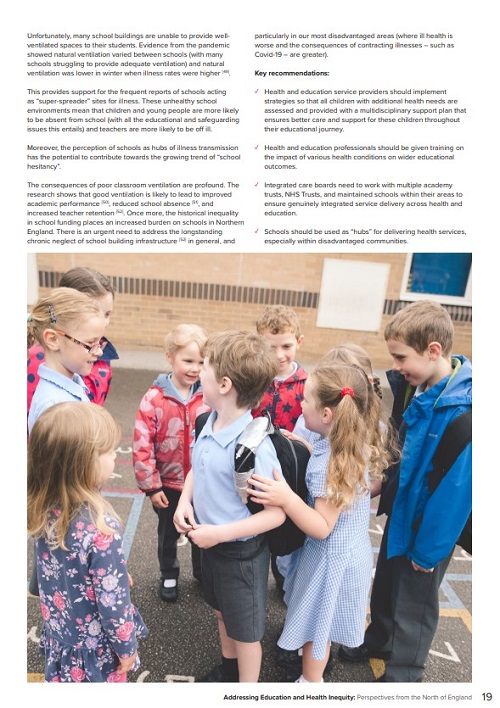【提案/コロナ103】の続きです。私は中性能フィルターのDIY空気清浄機をおすすめしており、我が家でも使っています。舞台芸術の稽古場にいかがですか?
北イングランドで行われたランダム化比較試験の結果、教室に空気清浄機を設置すると生徒の欠席率が大幅に低下することが分かったという発表。https://t.co/36G6XJTgTw
— Angama (@Angama_Market) September 12, 2023
「北イングランドで行われたランダム化比較試験の結果、教室に空気清浄機を設置すると生徒の欠席率が大幅に低下することが分かった」(2023年9月12日)という投稿を見つけたので、紹介されている英語資料を機械翻訳で確かめてみたところ、間違いありませんでした。その記録を載せておきます。以下は資料からのコピペ(機械翻訳含む)などです。
目次
■北イングランドの英語資料/表紙
・Health Equity North
https://www.healthequitynorth.co.uk/
「教育と健康の不平等への対処:イングランド北部からの視点」(2023年9月11日)
Addressing Education and Health Inequity:Perspectives from the North of England
https://www.healthequitynorth.co.uk/app/uploads/APPG-REPORT-SEPT-23.pdf
A report prepared for the Child of the North / All-Pary Parliamentary Group

■北イングランドの英語資料/18ページ【健全な学校づくり】
パンデミックは、校舎のインフラに関する多くの問題と、教室の適切な換気を確保することの難しさを浮き彫りにしました。学校における良好な換気と空気感染性感染症を結びつける状況証拠は充実している。
たとえば、屋外換気の改善と他の緩和戦略を併用した米国の学校では、他の地域に比べて新型コロナウイルス感染率が低かった[48]。ブラッドフォードの学校は、学校に空気清浄技術を導入すると、新型コロナウイルス感染症による欠席が大幅に減少するという直接的な証拠を提供する研究に参加した(第9章の「Class-ACT」ケーススタディを参照)。
【Creating healthy schools】
The pandemic highlighted many problems with school building infrastructure and the difficulty in ensuring classrooms are adequately ventilated. The circumstantial evidence linking good ventilation and airborne illness transmission in schools is substantial.
For example, US schools that used improved outdoor air ventilation together with other mitigation strategies had lower rates of Covid-19 transmission compared to the rest of the community [48]. Schools in Bradford participated in a study that provided direct evidence of significant reductions in Covid-19 illness absences when schools were fitted with air cleaning technologies (see the “Class-ACT” case study in Chapter 9).
■北イングランドの英語資料/19ページ【健全な学校づくり】
残念ながら、多くの校舎では生徒に十分に換気されたスペースを提供できません。パンデミックの証拠は、自然換気が学校によって異なり(多くの学校が十分な換気を提供するのに苦労している)、病気の発生率が高くなる冬には自然換気が低下することを示しました[49]
Unfortunately, many school buildings are unable to provide wellventilated spaces to their students. Evidence from the pandemic showed natural ventilation varied between schools (with many schools struggling to provide adequate ventilation) and natural ventilation was lower in winter when illness rates were higher [49].
これは、学校が病気の「スーパースプレッダー」サイトとして機能しているという頻繁な報告の裏付けとなります。こうした不健康な学校環境は、子供や若者が学校を欠席する可能性が高く(これには教育上および安全上のあらゆる問題が伴う)、教師が病気で休む可能性が高いことを意味します。
さらに、学校が病気の伝播の中心地であるという認識は、「学校への入学をためらう」傾向の拡大に寄与する可能性があります。
This provides support for the frequent reports of schools acting as “super-spreader” sites for illness. These unhealthy school environments mean that children and young people are more likely to be absent from school (with all the educational and safeguarding issues this entails) and teachers are more likely to be off ill.
Moreover, the perception of schools as hubs of illness transmission has the potential to contribute towards the growing trend of “school hesitancy”.
教室の換気が悪いと深刻な影響が生じます。研究では、良好な換気が学業成績の向上 [50]、不登校の減少 [51]、教師の定着率の向上 [52] につながる可能性が高いことを示しています。歴史的な学校資金の不平等により、再びイングランド北部の学校の負担が増大しています。一般に、特に最も恵まれない地域(健康状態が悪化し、新型コロナウイルス感染症などの感染症の影響がより大きい地域)において、長年にわたる慢性的な校舎インフラの放置 [52] に早急に対処する必要があります。
The consequences of poor classroom ventilation are profound. The research shows that good ventilation is likely to lead to improved academic performance [50], reduced school absence [51], and increased teacher retention [52]. Once more, the historical inequality in school funding places an increased burden on schools in Northern England. There is an urgent need to address the longstanding chronic neglect of school building infrastructure [52] in general, and particularly in our most disadvantaged areas (where ill health is worse and the consequences of contracting illnesses – such as Covid-19 – are greater).

■北イングランドの英語資料/27ページ:第9章「Class-ACT」ケーススタディ
【教室空気清浄技術 (Class-ACT) – 統合されたデータセットを使用して基礎的な研究課題に対処する方法】
新型コロナウイルス感染症のパンデミックにより、空気感染症の予防における良好な換気の重要性が強調されました [63、64、65]。多くの教室は換気が悪く、子供や職員が空気感染する病気にかかるリスクが高まっています[66]。換気の悪い教室に対する考えられる解決策の 1 つは、循環する空気から粒子を除去する「空気清浄技術」の提供です。これらには、新型コロナウイルスやその他の病原体、喘息や花粉症を引き起こす可能性のある粒子が含まれます。
Connected Bradford で利用可能なリンクされた健康データと教育データにより、Class-ACT プロジェクト [67] は、空気清浄技術が子どもたちの就学に与える影響を理解するためのランダム化試験を実施することができました。この研究では、健康記録と学校欠席を組み合わせることで、この研究では、健康記録と学校欠席を組み合わせることで、これらの比較的低コストの空気清浄技術を導入している学校では欠席率が大幅に低いことがわかりました。これらの接続されたデータセットがなければ、学校内に空気清浄技術を導入することによって病気の伝染が減少する可能性について、部分的な全体像を得ることができるだけです。
【Classroom Air Cleaning Technologies (Class-ACT) – how integrated datasets can be used to address fundamental research questions】
The Covid-19 pandemic highlighted the importance of good ventilation in the prevention of airborne diseases [63, 64, 65]. Many classrooms are poorly ventilated, which increases the risk of a child or member of staff contracting an airborne illness [66]. One possible solution to poorly ventilated classrooms is the provision of “air cleaning technologies” that remove particles from the circulating air. These include the Covid-19 virus and other pathogens, as well as particles that can cause asthma or hay fever.
The linked health and education data available in Connected Bradford allowed the Class-ACT project [67] to conduct a randomised trial to understand the impact that air cleaning technologies had on children’s attendance in school. By combining health records with school absences, the study found that schools that had these relatively low-cost air cleaning technologies fitted showed significantly lower absence rates. Without these connected datasets it would only be possible to obtain a piecemeal picture of the potential for disease transmission to be reduced through fitting air-cleaning technologies within schools.
■日本での「比較的低コストの空気清浄技術」使用例
英語資料の「比較的低コストの空気清浄技術」はおそらく参考文献 [66] にある「box fan air cleaners」を指し、米国で生まれた「コルジローゼンタールボックス」のことだと思われます。日本では(株)クレアが「クレアウィンボックス」という商品を販売しており、私はそれを使っています。(株)クレアの商品を買わなくても、ファン(扇風機)と箱があれば作れますので、DIYは可能です。ただしフィルターは中性能以上のものが必要です。
今日も家の中はクレアウィンボックスのおかげで空気清浄👌
10畳ぐらいだと弱運転でも飛行機並みにキレイなるのよ!
窓全開にすると粒子量は7500ぐらいまで上がる。CO2は窓閉まってると2000でピーピー鳴って、窓全開で600後半まで下がる。
公共交通機関や公共施設もいい加減、空気清浄に力を入れろ💢 pic.twitter.com/rvmnv2LmYg
— 社会人2年目 (@Syakaijinninen) August 30, 2023
ついに第9波でのクラスター発生。第7、8波の悲痛な思いを繰り返さないため、とっておきのクレアウィンボックスとフィルター投入。これで歯止めがかかってくれれば。 pic.twitter.com/ON6rP1GrJL
— umauma (@umauma50675103) September 7, 2023
⇒【楽天市場】クレアウィン ボックス+ファン+フィルター(20,000円)
https://item.rakuten.co.jp/suteteko/cra011/
⇒【楽天市場】クレアウィン ボックス+フィルター(11,000円)
https://item.rakuten.co.jp/suteteko/cra012/
⇒【楽天市場】クレアウィン ボックス(6,160円)
https://item.rakuten.co.jp/suteteko/cra010/
【coming soon】
お待たせして申し訳ありません。クレアウィンボックス、近々一般販売開始です。
価格はボックス単体6160円
+フィルター11000円
ファン付きフルセット20000円
で来週明け販売開始予定です。 https://t.co/PTI34xvv0G pic.twitter.com/lvG4Kejpvu— クレア🇯🇵ウイルス分離・除去する目的で作られたフィルター (@cleairwin_f) July 19, 2023
■英語資料の参考文献(Reference)
[48] E. R. Jones, M. V. Rainbolt, L. C. Marr, D. Michaels, L. R. Cadet, S. L. Miller, M. Levinson, L. Morawska, R. L. Corsi, N. R. ollock, Y. Li, A. P. S. Munro, K. Grier, Q. Chen, J. D. Macomber, X. Cao and J. G. Allen, “The First Four Healthy Building Strategies Every Building Should Pursue to Reduce Risk from COVID-19,” Lancet COVID-19 Commission Task Fource on Safe School, Safe Work, Safe Travel,2022.
[49] H. C. Burridge, S. Bontitsopoulos, C. Brown, H. Carter, K. Roberts, C. Vouriot, D. Weston, M. Mon-Williams, N. Williams and C. Noakes, “Variations in classroom ventilation during the COVID-19 pandemic: Insights from monitoring 36 naturally ventilated classrooms in the UK during 2021,” Journal of Building Engineering, vol. 63, no. Part B, 2023.
[50] W. J. Fisk, “The ventilation problem in schools: Literature review,” Indoor Air, vol. 27, no. 6, pp. 1039-1051, 2017.
[51] E. Simons, S. Hwang, E. F. Fitzgerald, C. Kielb and S. Lin, “The impact of school building conditions on student absenteeism in upstate New York,” American Journal of Public Health, vol. 100, no. 9, pp. 1679-1686, 2010.
[52] J. Buckley, M. Schnieder and Y. Shang, “The effects of school facility quality on teacher retention in urban school districts,” National Clearinghouse for Educational Facilities, 2004.
[63] A. M. Elsaid and M. S. Ahmed, “Indoor air quality strategies for air-conditioning and ventilation systems with the spread of the global Coronavirus (COVID-19) epidemic: Improvements and recommendations,” Environmental Research, vol. 199, p. 111314,
2021.
[64] S. Srivastava, X. Zhao, A. Manay and Q. Chen, “Effective ventilation and air disinfection system for reducing coronavirus disease 2019 (COVID-19) infection risk in office buildings,” Sustainable Cities and Society, vol. 75, p. 103408, 2021.
[65] M. Y. Z. Abouleish, “Indoor air quality and COVID-19,” Public Health, vol. 191, pp. 1-2, 2021.
[66] R. He, W. Liu, J. Elson, R. Vogt, C. Maranville and J. Hong, “Airborne transmission of COVID-19 and mitigation using box fan air cleaners in a poorly ventilated classroom,” Physics of Fluids, vol. 33, p. 057107, 2021.
[67] C. J. Noakes, H. C. Burridge, C. B. Beggs, S. Bontitsopoulos, C. J. Brown, J. Darling, R. G. Feltbower, S. Relins, S. Wood and M. Mon-Williams, “901 Class-ACT: the UK’s trial on the feasibility and effectiveness of air cleaning technologies in schools,” in Archives of Disease in Childhood, 2023.
驚きました!
とうとう、DIYで作れる、MERV13フィルター搭載の低コスト空気清浄機が、ホワイトハウスに入るそうです。Corsi-Rosenthal Boxとして名高いもの。
どれほど攻撃され無視されても、科学者たちが、コロナが空気感染であると説き続けた成果。
素晴らしいの一言です。 https://t.co/EFYuvmbZ6m— Chatteeniris (@lachattenoire78) September 10, 2022
